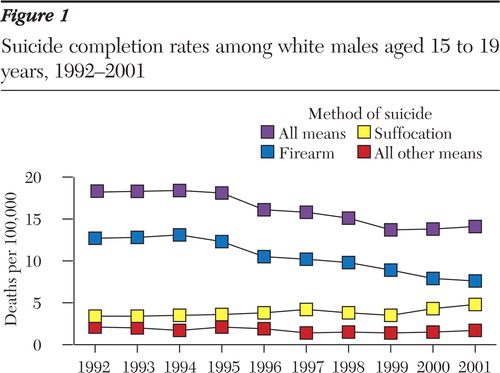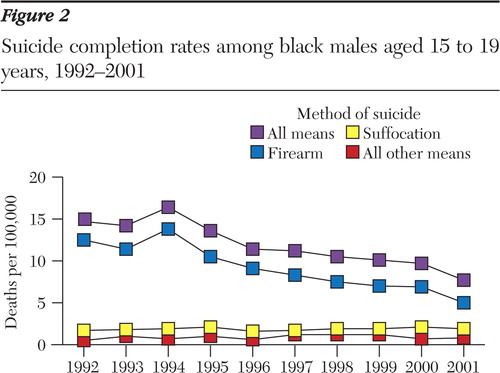Datapoints: Recent Trends in Suicide Among U.S. Adolescent Males, 1992-2001
In the United States black youths have historically had lower suicide rates than white youths, but the gap has been narrowing because of an increase in the suicide rate among young black males (1).
Using the mortality database from the Centers for Disease Control and Prevention's Wide-Ranging Online Data for Epidemiologic Research (2), we determined trends in suicide deaths between 1992 and 2001 for white males and black males aged 15 to 19 years. Trends in suicide were estimated by using negative binomial rate regression analyses.
As Figures 1 and 2 show, the overall suicide rate among white males decreased by an average of 3.9 percent annually (p<.001). The firearm suicide rate decreased by 6.6 percent annually (p<.001), and the rate of suicide by other means decreased by 3.9 percent annually (p=.002). However, there was an annual increase of 3.2 percent for suicide by suffocation (mostly hanging) (p<.001). In contrast, the overall suicide rate among black males decreased by 7.3 percent annually (p<.001), and nearly all the decrease was explained by a 10.2 percent annual decrease in the firearm suicide rate (p<.001).
Possible explanations for the recent decline in the youth suicide rate include the enactment of gun laws intended to keep firearms from youths (3) and the increasing use of selective serotonin reuptake inhibitors in the treatment of pediatric depression (1).
The firearm suicide rate has fallen substantially in recent years among both white and black adolescent males. This decline may be part of an overall downward trend in firearm deaths (2). The recent increase in suffocation suicides among white male teenagers may indicate that method-specific substitution is occurring. Our data underscore the need for health care providers to assess the availability of lethal means, and the risk for their use, and to make recommendations for their removal or safe storage.
Acknowledgments
This research was supported in part by grants K01-MH-69948, T32-MH-18951, and P30-MH-66371 from the National Institute of Mental Health and by a grant from the University Hospitals of Geneva.
The authors are affiliated with the division of child and adolescent psychiatry at the University of Pittsburgh School of Medicine, 3811 O'Hara Street, Pittsburgh, Pennsylvania 15213-2592 (e-mail, [email protected]). Dr. Barbe is also with the child and adolescent psychiatry service at the University Hospital of Geneva in Switzerland. Harold Alan Pincus, M.D., and Terri L. Tanielian, M.A., are editors of this column.

Figure 1. Suicide completion rates among white males aged 15 to 19 years, 1992-2001

Figure 2. Suicide completion rates among black males aged 15 to 19 years, 1992-2001
1. Gould MS, Greenberg T, Velting DM, et al: Youth suicide risk and preventive interventions: a review of the past 10 years. Journal of the American Academy of Child and Adolescent Psychiatry 42:386–405, 2003Crossref, Medline, Google Scholar
2. Compressed Mortality File: Underlying Cause-of-Death. Centers for Disease Control and Prevention, Wide-Ranging Online Data for Epidemiologic ResearchGoogle Scholar
3. Webster DW, Vernick JS, Zeoli AM, et al: Association between youth-focused firearm laws and youth suicides. JAMA 292:594–601, 2004Crossref, Medline, Google Scholar



